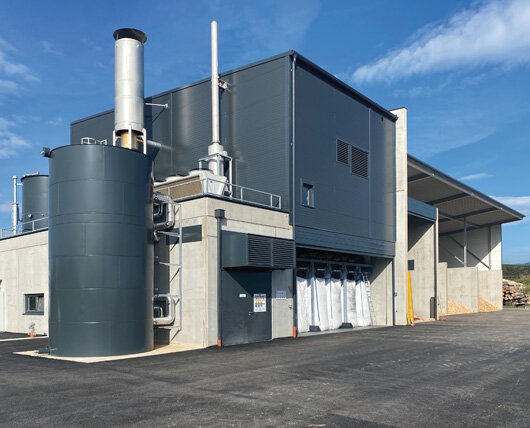New wood power system supplies energy while helping the climate
avus 500plus transforms wood gas into heat and electricity with enormous efficiency
Facts & figures

The biggest impact on global problems such as climate change can be made locally. The Austrian town of Ternitz is living proof of this statement. The community of 15,000 inhabitants is the scene for a ground-breaking project on the way towards the energy supply of the future: highly efficient, CO2-neutral – and so much more.
After a construction period of nine months, one of the world‘s most modern wood power systems commenced its operation as planned in July 2020. Also on the scene: an avus 500plus by 2G with 400 kW electrical and 600 kW thermal output.
The KWS Ökokraft, an energy supplier and wood gas generator specialist founded in 2017, commissioned the construction of this power station. Guided by its managing director, Marcel Huber, SynCraft serves as the main contractor of the system.
The primary resource needed to produce gas is provided in the form of forestry wastes. Before being processed, the wastes are dried first. Even during this first step, the focus on efficiency already has a notable impact, because the waste heat of the wood power system is used for the drying process.
Afterwards, the wood chips are transformed into a gaseous fuel, the wood gas, by a thermo-chemical process. A preliminary treatment or sorting is not required. Pins, bark, and even small metal parts such as screws can simply be processed by the system as well. This way, 267 kilograms of biodegradable fuel are processed every hour.
The produced wood gas is then directly fed into the combined heat and power system installed on site where it is transformed into electrical and thermal energy with an enormous efficiency. The CHP selected for this project was the avus 500plus by 2G – the project initiators around Marcel Huber, managing director of SynCraft, remain convinced that it was ‚exactly the right choice‘: "The avus 500plus by 2G is a reliable piece of the puzzle that is our power station, we can always rely upon it as far as supply security and efficiency are concerned“, explains Huber. The generated electricity is directly fed into the public grid and the heat is fed into the district heating network year-round. This way, the inhabitants of Ternitz can enjoy a stable and completely CO2-neutral energy supply.
CO2-neutrality is generally regarded as the Holy Grail of sustainable energy production, but the Austrians are going a significant step further with this wood power system. Biochar is a by-product of wood gas generation and in it, carbon dioxide is bound. In Ternitz alone, 3.7 m³ of biochar are produced daily – equating to 1.8 tons of CO2 emissions that are being bound.
If this biochar is then used for agricultural purposes, the carbon dioxide is bound long-term – a climate improving cycle begins to form. The so-called "reverse power system“ is not only CO2-neutral but it even has a sustainably positive impact on the environment and therefore deserves the distinction of being called "CO2-negative“. Thus, a local solution becomes a new global reference.





